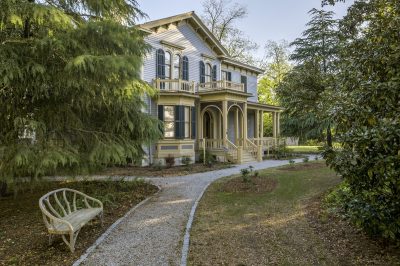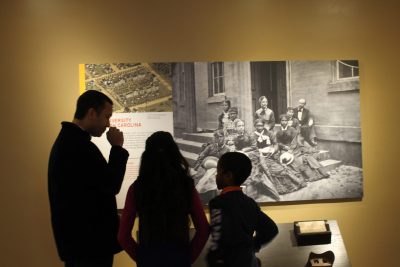Inclusive training at Historic Columbia
06 March 2017 – Jennifer Whitmer Taylor

The Wilson family constructed the Woodrow Wilson Family Home in Columbia, South Carolina during Reconstruction but only lived in the community for four years. Photo credit: Historic Columbia.
Believed to be the first museum of Reconstruction in the nation, the Woodrow Wilson Family Home (WWFH) reopened to the public on February 15, 2014 after being closed for nine years. Rather than focus solely on the life of Wilson, the new interpretation at the museum uses his teenage years living in Columbia, South Carolina as a lens to discuss one of the most misunderstood periods in American history. In order to successfully convert a presidential shrine into a Reconstruction museum, Historic Columbia—the administrator for the home—required a new training program for docents focused on language and cultural sensitivity. This program was designed to help docents use precise and inclusive language, understand privilege and the social construction of race and other identities, and interact with a diverse range of visitors.
Both volunteers and weekend staff, often pulled from the University of South Carolina’s (USC) public history program, were required to attend this interactive session conducted by USC scholars, Daniella Cook and Porchia Moore. Daniella Cook specializes in how class, race, and power impact public education. She designed and led the first session. Porchia Moore, who studies museum inclusivity, ran and expanded subsequent training sessions.
The inaugural version of the workshop was one hour long, and morning and evening sessions were offered to accommodate docents’ schedules. Eighteen volunteers and five paid docents completed the first training offered before the reopening. Historic Columbia ultimately extended the session to ninety minutes because of the lengthy conversations guided activities generated. Thirteen volunteers, eight of them new inductees, and two paid docents attended the second workshop held in April. Participation declined, however, to a handful of recently recruited docents for later sessions.
The language and sensitivity session combined with content training eased fears related to discussing race among some docents. Before and after the first training program, Historic Columbia administered a survey to gauge docents’ comfort level “talking with museum visitors about historical issues related to race.” After training, the six and half percent of docents taking the survey who previously were “not comfortable at all” with such conversations dropped to zero. Those “somewhat comfortable” remained nearly unchanged at just over thirty-five percent, but those “very comfortable” rose six percent to sixty-four percent. However, these statistics are not conclusive. Thirty-one docents completed the pre-training survey, but only fourteen of the twenty-three docents who completed training took the post-training survey. Of the 628 visitors who visited WWFH in 2014 and completed a survey on their experience, nearly eighty-four percent thought docents handled sensitive issues “extremely well.” These combined survey results suggest sensitivity programming is valuable for museums dealing with complex issues of race and seeking to create inclusive environments for all of their visitors.
A survey and oral history interviews I conducted as part of my dissertation on the transformation of WWFH reveal that older, white volunteers were more likely to be critical of the inclusivity workshop than paid docents. Ten volunteers and six weekend staffers participated in the survey and eleven gave oral histories. While white paid docents trained as public historians overwhelmingly embraced the workshop, the older, white volunteer docent base was divided about its effectiveness and need. The weekend staff welcomed and benefited from the training. Four weekend docents praised exercises related to white privilege, with one calling the session their favorite. The discussion of privilege resonated most with them. They spoke specifically about being able to “see visually” gendered, class, and racial privilege during the privilege walk. They expanded their understanding of the word “privilege” beyond an association with wealth by listening to incidents of discrimination experienced by leaders and attendees. After the session, one individual described being hyperaware of being a white docent telling the story of “terrible things that happened to black people” as a result of Reconstruction-era violence and being “a descendant” and “a beneficiary of that system” in the present. Only one docent offered constructive criticism, suggesting activities and examples be “directed” at the Wilson home rather than “general” inclusivity.

Visitors analyze an image of women who were training to be teachers at the short-lived integrated campus of South Carolina College, which eventually became the University of South Carolina. Photo credit: Historic Columbia.
Volunteers expressed a range of opinions and illuminated contradictions they saw in the training and their racial philosophies. They enjoyed and learned from the session, were ambivalent about it, or openly admitted disliking it. For one volunteer, the workshop was ranked as the least favorite, but several spoke of the session’s importance in both the training process and understanding white privilege. For the first time, some volunteers thought about privilege or considered the appropriateness of their word choices. Other volunteers attributed their opposition to their learning styles and exposure to diversity training outside of their volunteer work. In addition, some maintained that they already held progressive or neutral views on race. They argued group work in general did little to facilitate their learning and labeled some exercises too “touchy feely” and “silly.” The two volunteers who claimed the session added little to their previous professional diversity training used “the blacks” to refer to the black community in their oral histories. One volunteer, who recognized institutional racism and the challenges of white docents interpreting black history, called the session “one-sided.” The docent had shared a volunteer experience at a black history site where a black visitor argued all white baby boomers were racists. The docent thought her presence refuted this allegation and the visitor was prejudiced, but the session leader used the story to open a dialogue about perceptions of “white do-gooders.”
Regardless of the level of acceptance, several docents from both groups acknowledged exposure to the concept of white privilege mattered and was a critical concept for the tour. Recent graduate school attendance had previously exposed the majority of paid docents to concepts of inclusive language and privilege. Three concluded the training appealed to them on this intellectual level. If anything, it was the timing of one’s education, not the level of it obtained, which explained volunteers’ ambivalence about the session. Four docents, three of them volunteers, previously participated in diversity training as part of their professions. Only one of the volunteers from that group thought that there was nothing new to learn from the workshop. Furthermore, among the volunteers I surveyed, five held master’s degrees and two earned PhDs in a range of fields including history, English, political science, education, library sciences, and hospital administration.
Overall, the results of this project suggest training in language and cultural sensitivity is a best practice. It keeps an organization’s cadre of well-educated, retired volunteer docents current with cultural sensitivity theory and trends even if they do not fully embrace the ideas. It also appeals to professional public historians on staff. As one weekend staffer surmised, “We can all use a little more training on sensitivity and language.”
Readings:
“White Privilege: Unpacking the Invisible Knapsack”
Video: Second episode of Race: the Power of An Illusion
Handouts and Activities:
- Ten Things Everyone Should Know about Race
- “Tour Guide Etiquette: a Guide for the Well Intentioned Volunteer,” a modification of the pamphlet “Cultural Etiquette: a Guide for the Well-Intentioned
- “Challenging Your Assumptions,” modified from Teaching Tolerance: Writing for Change
- The privilege walk
~ Jennifer Whitmer Taylor, a PhD candidate in history at the University of South Carolina, is completing her dissertation Rebirth of the House Museum: The Woodrow Wilson Family Home and Commemorating Reconstruction. As lead facilitator of the museum, she crafted tours, trained docents, and evaluated audience reception.



